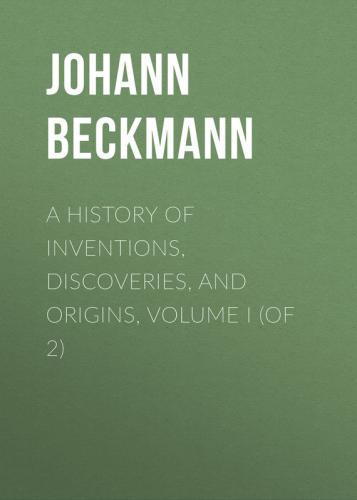412
Auson. Mosella, v. 362. Fortunati Carmina, Moguntiæ 1617, 4to, p. 83.
413
Gregorii Turonensis Opera, Paris, 1699, fol. Hist. lib. iii. 19, p. 126. Ibid. Vita Patrum, 18, p. 1242.
414
Gul. Britonis Philippidos libri xii. lib. vi. v. 220.
415
Chronicon Hierosolymitanum, edit. a Reineccio. Helms. 1584, 4to, lib. i. c. 10.
416
See Carpentieri Gloss. Nov. ad Scriptores medii, ævi, (Supp. ad Ducang.) Paris, 1766, fol. vol. i. p. 266. In a chronicle written in the year 1290, a floating-mill is called
417
Damiani Opera, ed. Cajetani. Paris, 1743, fol. i. p. 105, lib. vi. epist. 23.
418
Dell’ Origine di alcune Arti Principali Appresso i Veneziani. Ven. 1758, 4to, p. 71.
419
Dialog. i. 2.
420
Histor. Francorum, lib. ix. 38, p. 462.
421
See Pomponius Sabinus,
422
Lib. ix. c. 9; x. c. 1, 13.
423
Natur. Quæst. lib. v. c. 18.
424
Chrysost. in Psalm. cxxxiv. p. 362.
425
“At the same period (718) one named Halek the son of Uladi the weak, built close to the city an ingenious mill which was driven by water. It was visited by many Bohemians, in whom it excited much wonder, and who taking it as a model, built others of the like kind here and there on the rivers; for before that time all the Bohemian mills were wind-mills, erected on mountains.” – Wenceslai Hagecii Chronic. Bohem. translated into German by John Sandel. Nuremberg, 1697, fol. p. 13.
426
See De la Mare, Traité de la Police, &c.
427
There are no wind-mills at Ispahan nor in any part of Persia. The mills are all driven by water, by the hand, or by cattle. Voyages de Chardin. Rouen, 1723, 8vo, viii. p. 221. – The Arabs have no wind-mills; these are used in the East only in places where no streams are to be found; and in most parts the people make use of hand-mills. Those which I saw on Mount Lebanon and Mount Carmel had a great resemblance to those which are found in many parts of Italy. They are exceedingly simple and cost very little. The mill-stone and the wheel are fastened to the same axis. The wheel, if it can be so called, consists of eight hollow boards shaped like a shovel, placed across the axis. When the water falls with violence upon these boards it turns them round and puts in motion the mill-stone over which the corn is poured. – Darvieux, Reisen, Part iii. Copenh. 1754, 8vo. I did not see either water- or wind-mills in all Arabia. I however found an oil-press at Tehama, which was driven by oxen; and thence suppose that the Arabs have corn-mills of the like kind. – Niebuhr, p. 217.
428
Mabillon, Annales Ord. Benedicti. Paris, 1713, fol. p. 474.
429
Dugdale, Mon. i. p. 816. – The letter of donation, which appears also to be of the twelfth century, may be found in the same collection, ii. p. 459. In it occurs the expression
430
Decretal Greg. lib. iii. tit. 30. c. 23.
431
Zanetti,
432
Lehmann’s Chronica der Stadt Speyer. Frankf. 1662, 4to, p. 847. “Sent to the Netherlands for a miller who could grind with the wind-mill.”
433
Descriptions and figures of both kinds may be found in Leupold’s Theatrum Machinarum Generale. Leipzig, 1724, fol. p. 101, tab. 41, 42, 43.
434
De Rerum Varietate, lib. i. cap. 10.
435
This account I found in De Koophandel van Amsterdam, door Le Long. Amst. 1727, 2 vol. 8vo, ii. p. 584. “The moveable top for turning the mill round to every wind was first found out in the middle of the sixteenth century by a Fleming.” We read there that this is remarked by John Adrian Leegwater; of whom I know nothing more than what is related of him in the above work, that he was celebrated on account of various inventions, and died in 1650, in the 75th year of his age.
436
See Beschryving der Stadt Delft, Delft, 1729, folio 625.
437
Plin. lib. xviii. cap. 11.
438
At Midsummer 1502, machinery for bolting in mills was first introduced and employed at Zwikau; Nicholas Boller, who gave rise to this improvement, being then sworn master of the bakers’ company. It may be thence easily seen, that coarse and not bolted flour, such as is still used in many places, and as was used through necessity at Zwikau in 1641, was before that period used for baking. Chronica Cygnea, auct. Tob. Schmidten. Zwikau, 1656, v. vol. 4to, ii. p. 219. See also Theatri Freibergensis Chronicon. Freyberg, 1653, 4to, ii. p. 335. Anno 1580, a great drought and scarcity of water. Of all the mills near town there were only fifteen going; and in order that the people might be better supplied with meal, the bolting machinery was removed, and this was attended with such good consequences that each mill could grind as much as before. In Walser’s Appenzeller Chronik. 8vo, p. 471, we are told that about that time (1533), a freeman of Memmingen taught the people of Appenzel to make the beautiful white bolted flour so much and so far celebrated.
439
Transactions of the Economical Society at Leipsic, 1772. Dresden, 8vo, p. 79.
440
According to the general rescript of 1750, which has been often renewed. The company obtained this exclusive right as early as the year 1668.
1613
Nicholson’s Journal, July 1800, p. 179.
1614
Philosophical Magazine, 1805.
1615
Phil. Trans. 1831, p. 147.
